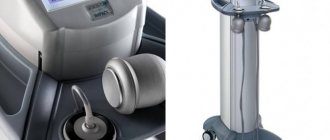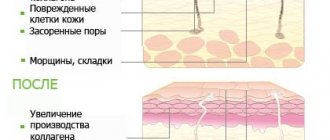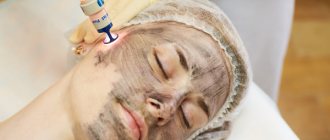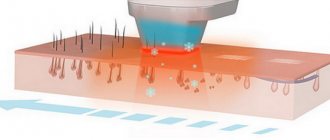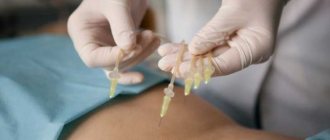Every person dreams of healthy and qualitatively renewed skin. Unfortunately, the aging process is an inevitable and obligatory process in the body. Over the years, the skin becomes less elastic, acquiring pronounced porosity, noticeable wrinkles, and age-related pigmentation. Is it possible to cope with such problems?
Fraxel, better known as fractional laser photothermolysis, is considered one of the most effective means in the fight against aging and other skin defects. This rejuvenation technique is carried out non-surgically; it is based only on the correct laser radiation. In this case, the laser beam is divided fractionally into hundreds of individual beams, thanks to which it becomes possible to accurately calculate the intensity and depth of impact on the problem. This feature of the procedure results in a positive final result.
In the process of photothermolysis, broken into fractions, the process of destruction of part of the cellular structures on the surface of the skin occurs. We are talking about 30% controlled destruction of cells with their subsequent regeneration, as well as the production of elastin, as well as collagen fibers. Thanks to the activation of the skin's internal reserves, the promised result is achieved even after several procedures.
Fraxel rejuvenation and indications for it
This procedure is recommended for use solely for aesthetic needs and indications, namely:
- the presence of wrinkles (minor ramifications under the eyes), decreased elasticity, as well as decreased tone;
- defects in the relief of the skin (presence of stretch marks, increased porosity, even in the area of the mammary glands);
- changes in the skin towards scarring of various types of localization and shape (post-traumatic nature, post-operative, post-burn, as well as traces of severe acne, etc.;
- melasma and age spots (age-related);
- aging processes (withered skin) in the neck, face, and hands;
- the patient’s desire to influence the condition of the skin of any part of the body, for example the abdomen or décolleté.
Indications
The FRAXEL procedure is indicated for use in the presence of the following defects and epithelial pathologies:
- stretch marks;
- withering of the dermis;
- freckles;
- wrinkles;
- acne marks;
- crow's feet;
- melasma;
- pigmentation;
- excess epithelium in the eyelid area;
- post-operative, post-traumatic scars.
This video will tell you how the procedure goes:
Varieties of Fraxel rejuvenation
There are four types of Fraxel rejuvenation. Each of them differs in the depth of its effect on the surface of the skin. Let's look at each of them separately:
Fraxel re:store is considered to be a classic version of fractional photothermolysis. The depth of influence ranges from 0.4-1.4 mm. The operating wavelength is about 1550 nm. Because of Re:store, the Fraxel brand is considered synonymous with “fractional photothermolysis.” Flexible settings and balanced performance characteristics in this procedure can provide positive results in the industry of removing scars, burn marks, scars, including post-acne.
Fraxel re:store DUAL is one of the most advanced treatments from the re:store brand. Two lasers fit into a single device: thulium fiber optic (Tm:fiber) and erbium fiber optic classic (Er:fiber). The wavelength of the first is about 1927 nm, and the second is 1550 nm. Increased control over skin coverage is about 70% in the treatment area. The procedure also guarantees uniform exposure of the beam over the surface, which allows you to set different intensities without subsequent complications for the body. The technique is based on the ideal ratio of deep remodeling of the layers of the dermis, as well as regeneration of the epidermis. This combination is extremely suitable for the treatment of scars, stretch marks, elimination of pigment formations, as well as for the purpose of smoothing out wrinkles.
Fraxel Re:fine involves superficial laser penetration under the layers of the skin. This procedure is one of the mildest and least traumatic in its effects. Fractional laser boasts a huge number of noticeable advantages, including its softness. Thanks to them, the rehabilitation period is noticeably reduced. Due to its gentleness, this procedure is suitable even for delicate areas of the body, for example, the mammary glands and eyelid area. Re:fine works by fractional photothermolysis. The penetration depth of the laser beam is up to 0.65 mm. The operating wavelength reaches -1410 nm. Fraxel re:pair is able to affect the deep layers of the dermis. This procedure is extremely effective in eliminating noticeable wrinkles, scar-type deformities, as well as vascular dyschromia. It is used to uniform skin texture, reduce porosity and treat hyperpigmentation. In plastic surgery, Fraxel re:pair is often combined with lifting operations. This is necessary for the purpose of rejuvenating the skin in combination with braces.
Palomar or Fraxel - general qualities:
1. The first important quality that allows you to compare these devices is American production. It is known that America is the most progressive country in the development of cosmetology techniques, and the quality of American equipment has long proven itself throughout the world. Therefore, we can say with confidence that no matter which device you choose - Palomar or Fraxel - both will meet international quality criteria.
2. Both devices implement the technique of non-ablative fractional photothermolysis - laser rejuvenation, which does not damage the upper stratum corneum of the skin - the epidermis. This allows the procedure to be carried out with high efficiency and a short rehabilitation period. It is this technique that today is the most popular and popular type of laser rejuvenation all over the world.
Session and its sequence
Before starting the procedure, thorough cleansing of the skin is recommended. An anesthetic is applied to the treated area, often a lidocaine-based gel. After some time, literally a few minutes, it is washed off, and an ointment is applied to the skin to make it easier to move the attachment of the device.
The procedure for treating the skin with a laser beam is carried out taking into account a certain sequence of actions. The duration of a fractional photothermolysis session often does not exceed 30 minutes. The time depends on the area of the surface being treated with the Fraxel laser. For example, a procedure for treating the face can take from 20 to 30 minutes, and the hips or abdominal area up to 40 minutes. One session, including preparation for it, can take a whole hour.
The sensations experienced during the procedure depend on the skin in the treatment area and its thickness. Most patients feel a slight burning sensation or slight tingling. It is worth noting that in addition to the anesthetic, a cooling air flow is used, which is supplied continuously. Thanks to these features, the Fraxel procedure is considered acceptable and comfortable. After this, a light cream is applied to the treated area of the skin, which eliminates swelling and hyperemia. It is recommended to repeat the session no earlier than after a couple of weeks. The total number of necessary procedures is determined by the doctor on a purely individual basis. A standard rejuvenation course consists of 3 or 4 procedures, which are best repeated at intervals of four weeks. In order to eliminate scars, the number of possible procedures can be expanded to 8.
- For people with sensitive skin, it is better to minimize exposure to direct sun rays for a month after the Fraxel procedure. To do this, on hot summer days it is better to use cosmetics with an increased barrier of protection against ultraviolet radiation (over 30) for 2 or 3 months.
- During the first weeks, it is recommended to apply moisturizing cosmetics to the laser-treated area, for example, a lightweight cream that does not clog pores.
- The use of peelings and other grinding agents is strictly prohibited during the first 2 weeks after the procedure. The application of decorative cosmetics is allowed even for the next day.
Quite often, swelling or redness appears on the skin a couple of days after the procedure. Such manifestations are considered to be a truly natural reaction of the body; it indicates the beginning of regeneration and rejuvenation.
The second indicator of change is peeling of the skin (rejection of old skin cells), which lasts about a week. Such discomfort is eliminated by applying a cream with a moisturizing effect. The tanning effect (so-called bronzing) may linger for approximately 2 weeks after the procedure.
It is worth noting that the desired rejuvenation will reach its maximum effect towards the end of the month after Fraxel. It is fractional photothermolysis that makes the skin noticeably healthier and younger. Sessions of this procedure have a cumulative effect, so the final result can last for 10 or 15 years.
TYPES OF FRACTIONAL PEELING
Fraxel laser peeling can be divided into the following types:
- Non-ablative treatment (without damaging the skin).
- Ablative treatment (with tissue damage):
- Incomplete (fractional thermolysis);
- Full (laser resurfacing).
We recommend: DEEP FACIAL PEELING: with your daughter like sisters
To simplify greatly, these 3 types differ from each other, like superficial, medium and deep laser peels.
Complications from fractional photothermolysis, contraindications and side effects
Like other methods of hardware cosmetology, this procedure has a list of contraindications for its use:
- oncological diseases;
- manifestations of epilepsy;
- atopic dermatitis, as well as psoriasis;
- inflammation in the area of skin where the procedure is planned (psoriasis or neurodermatitis);
- herpetic rashes;
- infectious diseases that occur in acute form;
- performed deep or medium chemical peeling;
- dermabrasion (mechanical) performed a week before the procedure;
- period of lactation or pregnancy;
- allergy to lidocaine.
The last reading is considered relative.
Since the Fraxel procedure is considered a type of laser peeling, it is characterized by similar side effects. The most common problems are acne, erosion, herpes virus infection, etc. More rare, but still occurring, problems include: prolonged erythema, post-inflammatory hyperpigmentation, allergies, swelling, etc.
Fraxel cost
You need to know that the final cost of the procedure consists of three main factors, namely: the dimensions of the treatment area, the brand of working equipment, and the number of procedures. Today's prices for one Fraxel rejuvenation procedure in the capital are as follows:
- facial area about – 25,000 rubles;
- neck, face and décolleté – over 40,000 rubles;
- stomach, buttocks, mammary glands are charged 55 rubles per 1 cm²;
- forearm and hand area from RUB 15,000;
- fighting scars costs about 1000 rubles. 1 cm from the length.
Price and clinics
The cost of fractional rejuvenation varies between 5,500 – 44,000 rubles. The price is affected by the area that needs to be affected by the laser beams. The cost of one local anesthesia is 660 rubles.
We indicate the average prices for rejuvenation of different areas of the skin in the table.
| Area of influence | Price |
| Neck | 16 – 19 thousand rubles. |
| Face + chin area | 29 – 30 thousand rubles. |
| Face + eyelids + chin | 31 – 32 thousand rubles. |
| Neck + décolleté | 33 – 34 thousand rubles. |
| Face + décolleté + neck | 57 – 58 thousand rubles. |
| Neckline area | 20 – 21 thousand rubles. |
| Back of the hands | 12 – 13 thousand rubles. |
| Cheeks | 9 – 10 thousand rubles. |
| Nose | 5 – 6 thousand rubles. |
| Eyebrow area | 3 – 4 thousand rubles. |
| "Crow's Feet" | 4 – 5 thousand rubles. |
| Whiskey | 5 – 6 thousand rubles. |
| Eyelids | 6 – 7 thousand rubles. |
| Forehead | 12 – 13 thousand rubles. |
| Nasolabial triangle | 5 – 6 thousand rubles. |
